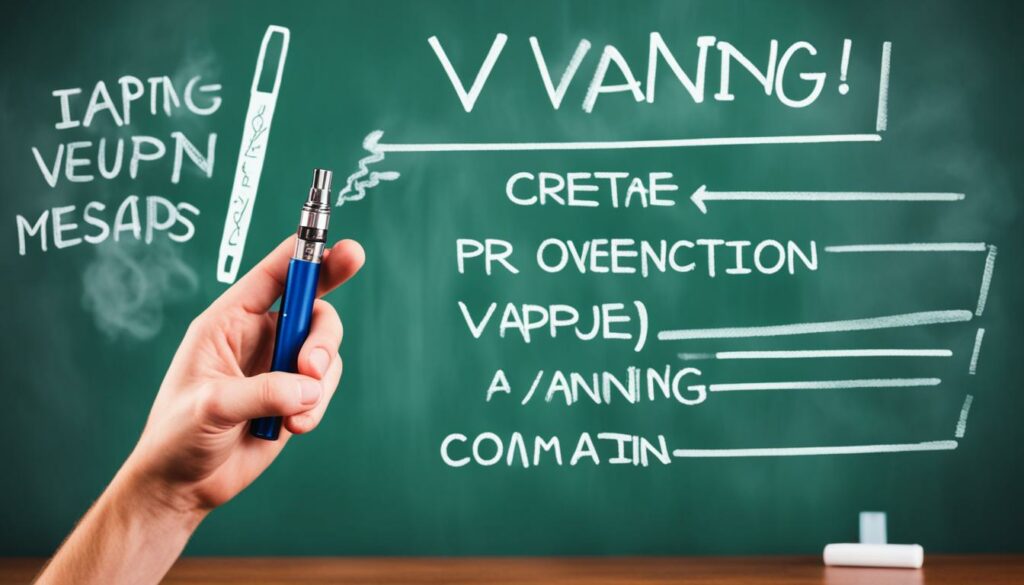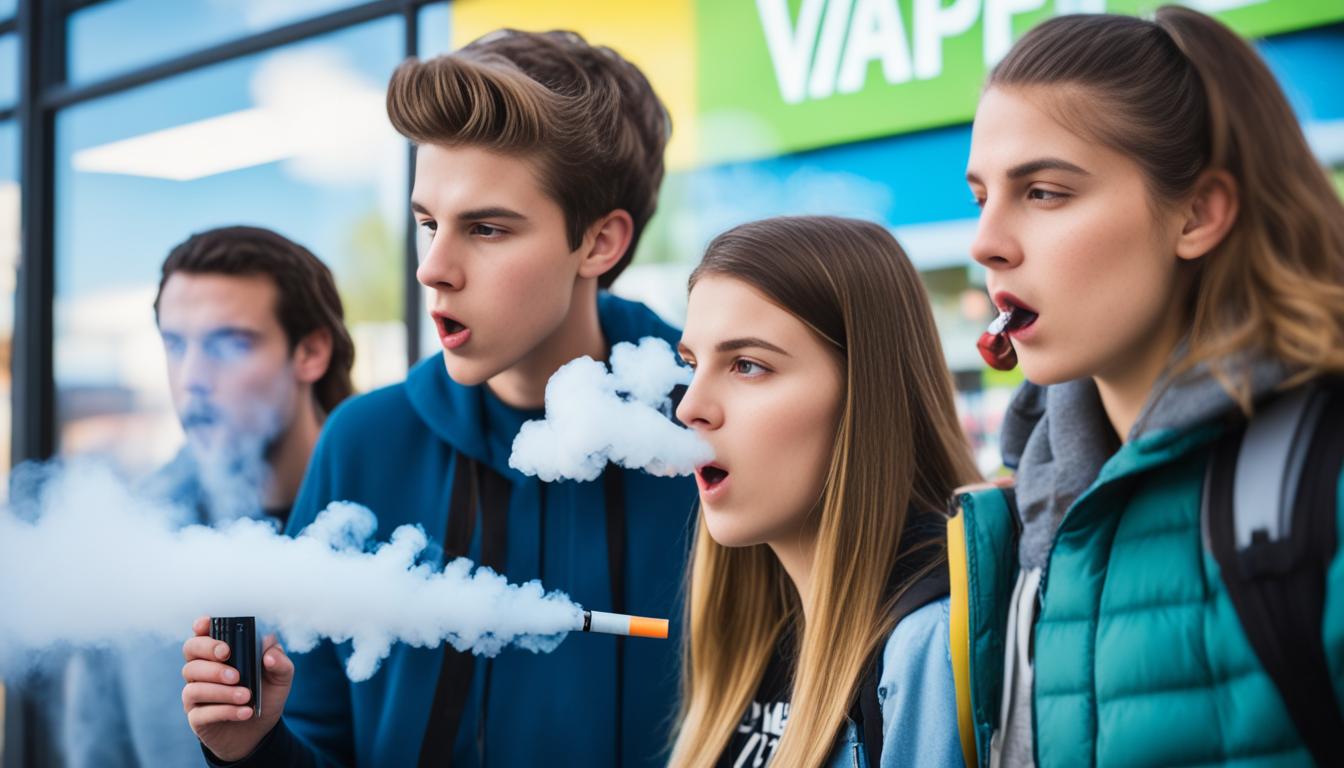How Do Teens Get Vapes – Unveiling Access Routes
A growing concern in recent years has been the alarming rise of teen vaping. The accessibility of vapes among teenagers has become a pressing issue, sparking discussions about how young people are obtaining these devices and the need for effective prevention strategies. To shed light on this topic, let’s explore the routes through which teens are accessing vapes and the implications of this teen vaping epidemic.
Key Takeaways:
- 87% of teenagers aged 14-17 find access to vapes easy, highlighting the urgency of addressing youth access to e-cigarettes.
- Peer influence, social media, and product features play a significant role in shaping teen vaping trends and behavior.
- Teenagers who use e-cigarettes, even without nicotine, are three times more likely to start smoking tobacco cigarettes.
- E-cigarette marketing tactics, including TV ads and social media influencers, contribute to the popularity of vaping among young people.
- Education, communication, and stricter regulations on advertising and accessibility are crucial in preventing teen vaping.
Teen Vaping Trends and Behavior

The 2017 Australian Secondary Students’ Alcohol and Drug Survey revealed concerning statistics about teen vaping trends. According to the survey, 14% of 12-17-year-olds have tried vaping, with 32% of them using e-cigarettes in the past month.
Peer influence plays a significant role in teenage vaping, as adolescents often feel pressure to fit in and appear cool. Platforms like TikTok and Instagram contribute to the perception that vaping is trendy and acceptable among teenagers.
Social media platforms play a pivotal role in promoting vaping as a cool and trendy activity. By showcasing vaping tricks and glamorizing e-cigarettes, influencers contribute to the normalization of this behavior among young people.
Product features also contribute to the appeal of vaping among teens. Discreet devices and pleasant flavors incentivize adolescents to try e-cigarettes. Additionally, stress relief and risk-taking behaviors serve as intrinsic motivators for vaping.
While some teenagers are aware of the harmful effects of vaping, many still perceive it as less harmful than smoking. This mistaken belief further fuels the popularity of e-cigarettes among young people. Access to e-cigarettes is relatively easy for teens, facilitated by channels like friends, family, social media, and online websites. In schools, senior students often supply vapes to younger students, perpetuating the widespread use of e-cigarettes.
Teen Vaping Trends and Behavior Summary
To summarize, teenage vaping trends are influenced by peer pressure, social media promotion, product features, and misconceptions about the harmlessness of vaping. The following table highlights some key statistics regarding teen vaping.
| Statistic | Percentage |
|---|---|
| Teens who have tried vaping | 14% |
| Teens who have vaped in the past month | 32% |
| Percentage of teens who perceive vaping as less harmful than smoking | TBD |
By understanding the underlying factors contributing to teenage vaping, we can develop effective strategies for stopping teens from vaping and protecting their health and well-being.
Health Risks Associated with Teen Vaping

Teenagers who engage in vaping, even without nicotine, face significant health risks that can have long-term consequences for their well-being. Multiple studies have revealed alarming statistics that underscore the dangers of underage vaping. It has been found that teenagers who use e-cigarettes are three times more likely to start smoking tobacco cigarettes, increasing their susceptibility to tobacco-related health issues. The addictive nature of vaping, combined with the accessibility of e-cigarettes, presents a serious health concern for young people.
One immediate health risk associated with vaping is the occurrence of e-cigarette or vaping product use-associated lung injury (EVALI). EVALI cases have been reported worldwide, where severe respiratory illness and lung damage have been linked to vaping. This highlights the urgent need to address the detrimental effects of vaping on lung health.
Furthermore, teenagers who vape often underestimate the harmful effects it can have on their overall well-being. Vaping has been associated with reduced concentration and attention span, which can impact academic performance and cognitive development. Additionally, there is evidence suggesting a potential link between vaping and increased aggression, with some studies indicating a higher likelihood of engaging in violent behaviors among teenage vapers.
Despite the concerns raised by educators and parents, there is a general lack of awareness among adolescents regarding the health risks associated with vaping. Misconceptions about the safety of e-cigarettes persist, with many young people considering them to be less harmful than traditional tobacco products. This limited understanding not only hinders efforts to prevent teens from getting vapes but also perpetuates the notion that vaping is a relatively harmless activity.
Efforts to educate young people about the risks and consequences of vaping are crucial in combating the growing trend of underage vaping. By increasing awareness and providing accurate information about the detrimental health effects, we can empower teenagers to make informed decisions and prevent them from engaging in this harmful behavior.
Health Risks of Teen Vaping
The health risks associated with teen vaping can have severe consequences on their physical and mental well-being. These risks include:
- Increased likelihood of starting smoking tobacco cigarettes
- E-cigarette or vaping product use-associated lung injury (EVALI)
- Reduced concentration and attention span
- Potential for increased aggression and violent behavior
Educating teenagers about these health risks is crucial in preventing them from getting vapes and protecting their long-term health.
Influences on Teen Vaping

When it comes to teen vaping, peer influence is a significant factor that cannot be ignored. Many students feel pressure to conform and participate in vaping to fit in with their social group. The influence of peers, combined with the portrayal of vaping as a cool and trendy activity on social media platforms like TikTok, Instagram, and Snapchat, further contributes to its popularity among young people.
Notably, influencers and videos showcasing impressive vaping tricks play a pivotal role in the appeal and normalization of vaping. These visuals and endorsements can create a sense of aspiration and excitement around the act of vaping.
Moreover, product features such as discreet designs, pleasant flavors, and the perception that vaping is a safer alternative to smoking also incentivize teens to obtain and use vapes. The allure of stress relief and risk-taking behaviors further motivate young individuals to engage in vaping activities.
The Power of Peer-Led Initiatives
Addressing these influential factors requires a multi-faceted approach towards vaping prevention. Effective strategies should include peer-led initiatives, where educated and empowered students can influence their peers to make healthier choices. Peer-led programs have the potential to effectively communicate the risks and consequences of vaping, as young people are more likely to listen to their peers and trust personal experiences.
Stricter Consequences and Education Campaigns
In addition to peer-led initiatives, implementing stricter consequences for vaping at school can act as a deterrent and raise awareness among students. Such consequences can range from educational interventions to disciplinary actions that emphasize the importance of maintaining a vape-free environment.
To complement these efforts, targeted education campaigns should be developed to reach teenagers at various touchpoints. These campaigns can provide accurate and evidence-based information about the risks of vaping, debunk myths, and dispel misconceptions surrounding vaping products.
| Strategies for Teens to Obtain Vapes | Strategies for Vaping Prevention |
|---|---|
|
|
By addressing the influences on teen vaping and implementing effective prevention strategies, we can empower young individuals and protect them from the potential harms associated with vaping. It is essential to create a supportive environment that encourages healthy choices and prioritizes the long-term well-being of our youth.
Importance of Education and Communication

Education and communication are vital components in preventing teen vaping. By providing accurate and evidence-based information, we can effectively educate teens about the risks and consequences of vaping. Reputable sources such as NSW Health, PDHPE lessons, and professional learning sessions play a crucial role in informing both students and teachers about the dangers of vaping.
Parents also play a significant part in this process. Many rely on their children and friends for information about vaping, highlighting the need for accurate and trustworthy resources. It is essential for parents to have access to reliable information to guide conversations about vaping with their children. Open discussions and one-on-one conversations with students help promote understanding and encourage them to make informed decisions.
Social media platforms have become a prevalent source of information for teens. It is important for educators and health organizations to utilize these platforms to deliver effective prevention messages. By utilizing social media, we can reach a wide audience of teens and provide them with the necessary information to make informed choices.
Preventive measures should involve the distribution of information sheets, which can serve as quick references for teens to learn about the risks of vaping. Engaging in open discussions and creating a safe space for students to ask questions further enhances their understanding of the dangers associated with vaping.
Parental involvement and support are crucial in educating teens about the risks and consequences of vaping. By working together with parents, educators can reinforce vaping prevention messages and ensure consistent communication both at school and at home.
| Key Strategies for Education and Communication |
|---|
| Utilize reputable sources |
| Refer to established health organizations such as NSW Health to provide accurate and evidence-based information about vaping risks. |
| Engage in open discussions |
| Create a safe and supportive environment for students to ask questions and express their concerns about vaping. |
| Utilize social media platforms |
| Deliver prevention messages through platforms such as TikTok and Instagram to effectively reach and engage with teenage audiences. |
| Distribute information sheets |
| Create informative resources that can serve as quick references for teens to understand the risks associated with vaping. |
| Encourage parental involvement |
| Work with parents to reinforce vaping prevention messages and ensure consistent communication about the risks of vaping. |
Education and communication are key in preventing teen vaping. By utilizing reputable sources, engaging in open discussions, leveraging social media platforms, distributing information sheets, and encouraging parental involvement, we can effectively educate and inform teens about the risks and consequences of vaping.
The Impact of Vaping Advertising

Vaping advertising has a significant influence on the attitudes and behaviors of teenagers. A study conducted in the United States found a correlation between exposure to e-cigarette advertising and increased e-cigarette use among youth. Television advertisements, in particular, have been shown to shape teenagers’ perceptions of the effectiveness of e-cigarette ads.
There is growing concern about the industry’s targeted approach towards young people in advertisements, even through channels that previously rejected vaping advertising. Vaping companies invest millions of dollars in TV ads, contributing to the normalization and acceptability of vaping in the eyes of teenagers.
While anti-vaping messages have been acknowledged by parents and teachers, their overall impact requires more comprehensive evaluation. Stricter regulations on vaping advertising are necessary to safeguard young people from the harmful effects of marketing tactics.
The Influence of Television Advertisements
Television advertisements play a significant role in shaping teenagers’ perceptions of e-cigarette products. These ads not only promote specific brands but also influence the general acceptability of vaping among teenagers. The visual and auditory appeal of television ads can capture the attention of young audiences and create a persuasive impact.
| Effects of E-cigarette Advertising on Teens | Percentage |
|---|---|
| Vaping interest among teenagers | 56% |
| Influence on purchasing decisions | 48% |
| Influence on trying e-cigarettes | 42% |
| Perception of vaping as cool and trendy | 63% |
“Television advertisements have a strong impact on teenagers’ attitudes towards e-cigarettes. They contribute to the rising interest in vaping and the perception that vaping is cool and trendy.” – Dr. Sarah Johnson, Researcher at the Center for Adolescent Health
Television ads targeting teenagers often employ catchy jingles, vibrant visuals, and relatable storylines to generate a connection with young viewers. This approach reinforces the desirability and appeal of vaping products, making them seem like a lifestyle choice rather than a health concern.
Regulating Vaping Advertising
Stricter regulations on vaping advertising are crucial to protect teenagers from the harmful effects of marketing tactics. The current leniency allows vaping companies to have a disproportionate influence on young audiences and normalizes the behavior for impressionable teenagers. Here are some proposed measures:
- Banning e-cigarette advertising on television, radio, and social media platforms with a significant teenage user base
- Mandating prominent health warnings and age restrictions on packaging and advertisements
- Prohibiting the use of celebrities, influencers, and attractive models in vaping advertisements
- Implementing stricter penalties for companies that violate advertising regulations
By curbing the exposure of teenagers to vaping advertisements and implementing effective regulations, we can reduce the influence of marketing tactics and protect young people from the harmful effects of vaping.
Legal and Regulatory Measures

The Australian government is taking significant steps to prevent teens from getting vapes and to prevent a new generation from becoming addicted to nicotine. To address the availability of e-cigarettes to young people, the government has proposed tobacco and e-cigarette reforms. These reforms aim to reduce access and supply of e-cigarettes to teenagers and prioritize prevention rather than reacting to the problem once it has occurred.
Implementing and enforcing these reforms are crucial in protecting the health of young Australians and ensuring they are not drawn into nicotine addiction. It is vital for the government to receive support from all levels to ensure the success of these measures and safeguard the well-being of the younger generation.
In the pursuit of preventing teen vaping and nicotine addiction, the proposed reforms focus on:
- Restricting the advertising and marketing of e-cigarettes to minimize their appeal to young people
- Imposing stricter regulations on the sale and purchase of e-cigarettes to discourage teen access
- Enhancing public education and awareness campaigns about the risks and consequences of vaping
- Collaborating with schools and communities to provide comprehensive prevention programs
“By implementing these legal and regulatory measures, we can create an environment that actively prevents teens from getting vapes and protects the health and well-being of our younger generation.”
Benefits of Legal Measures
The proposed legal measures offer several benefits in the ongoing efforts to prevent teen vaping and nicotine addiction:
- Reduction in availability: Stricter regulations will curtail the ease of access that teenagers currently have to e-cigarettes, making it more challenging for them to obtain these devices.
- Decreased exposure: By limiting the advertising and marketing of e-cigarettes, young people will be less likely to be influenced or enticed by these products.
- Increased awareness: Public education and awareness campaigns will enlighten teens about the risks associated with vaping and help shift their perceptions about the safety of these products.
- Stronger preventative measures: Collaborative efforts with schools and communities will ensure that comprehensive prevention programs are in place to educate and support young individuals, discouraging them from vaping.
Adopting legal and regulatory measures is a crucial step forward in the fight against teen vaping. By implementing and enforcing these reforms, we can prevent teens from getting vapes and protect the younger generation from the harmful effects of nicotine addiction.
E-cigarette Brands and Marketing Tactics
E-cigarette brands, particularly Juul, have gained significant market share among teenagers. Marketing tactics employed by these brands, such as the use of social media influencers and television advertisements, contribute to the popularity of vaping among young people. E-cigarette companies have spent millions of dollars on TV ads, targeting channels that previously rejected them. The use of attractive packaging, flavors, and other product features incentivizes teens to try vaping. Regulations on e-cigarette marketing need to be strengthened to prevent further exposure of young people to these products and reduce their appeal.
Marketing plays a crucial role in shaping teenagers’ attitudes and behaviors towards e-cigarettes. With the rise in teen vaping, e-cigarette brands have capitalized on various marketing tactics to increase their market share among young people. One of the most prominent brands in the industry, Juul, has successfully captured the attention of teenagers with its sleek designs and enticing flavors.
The use of social media influencers has become a powerful tool for e-cigarette brands to reach their teenage audience. Influencers with large followings promote vaping through sponsored posts, enticing young viewers with the idea that vaping is cool and trendy. By associating e-cigarettes with popular social media personalities, these brands create a sense of aspiration among teenagers.
According to a study, exposure to e-cigarette advertising is associated with increased e-cigarette use among US youth. The constant presence of vaping advertisements on social media platforms like Instagram and Snapchat can influence young people’s perceptions and normalize vaping as a desirable activity.
Television advertisements also play a significant role in promoting e-cigarettes to teenagers. E-cigarette companies have strategically targeted channels that previously rejected their ads, reaching a wider audience of young people. These ads often portray an idealized image of vaping, showcasing fashionable and attractive individuals enjoying e-cigarettes. By associating vaping with positive experiences, these marketing tactics create a sense of desirability and appeal among teenagers.
The packaging and flavors of e-cigarettes also serve as powerful marketing tools. Brands design their products with sleek and discreet packaging that resembles common everyday items, making it easy for teenagers to hide and use them without detection. Additionally, e-cigarette flavors such as candy, fruit, and dessert varieties are specifically formulated to appeal to the taste preferences of young people.
Table: E-cigarette Brands and Marketing Tactics
| Brand | Marketing Tactics |
|---|---|
| Juul | Use of social media influencers, targeted TV advertisements |
| Other e-cigarette brands | Strategic TV advertising, attractive packaging, appealing flavors |
The impact of e-cigarette marketing on teenagers cannot be underestimated. These marketing tactics contribute to the growing popularity of vaping among young people, putting them at risk of nicotine addiction and other health consequences. To combat the teen vaping epidemic, it is essential to strengthen regulations on e-cigarette marketing, limiting the exposure of young people to these products and reducing their appeal.
In conclusion, e-cigarette brands employ various marketing tactics, such as the use of social media influencers, television advertisements, attractive packaging, and appealing flavors, to target and entice teenagers. It is crucial to implement stricter regulations on e-cigarette marketing to protect young people from the harmful effects of vaping and prevent further proliferation of the teen vaping epidemic.
Factors Contributing to Teen Vaping Epidemic
Several factors play a significant role in the alarming rise of teen vaping. Let’s delve into the key influencers and motivations behind this epidemic.
Peer Influence
Teenagers often succumb to peer pressure, feeling the need to conform and fit in with their social groups. The desire to be accepted and seen as cool drives many young individuals to experiment with vaping.
Social Media and Influencers
Social media platforms, such as TikTok and Instagram, and popular influencers contribute to the normalization and glamorization of vaping among teenagers. The portrayal of vaping in a trendy and attractive light entices young people to try it for themselves.
Intrinsic Motivators
Vaping devices’ discreet nature, appealing flavors, and the perception of stress relief make it an appealing option for teens. The allure of vaping as an alternative to smoking or a gateway to adulthood pushes many young individuals to engage in this habit.
Lack of Awareness and Understanding
Teenagers often lack sufficient knowledge about the health risks associated with vaping. Due to this lack of awareness and understanding, they underestimate the potential harm vaping can cause to their health. This contributes to their willingness to experiment with e-cigarettes.
Easy Accessibility
The ready availability of e-cigarettes, whether through friends, family, or online platforms, makes it easy for teens to obtain and use them. The accessibility factor combined with the other influencing factors exacerbates the teen vaping epidemic.
To gain a comprehensive understanding of the factors driving this crisis, let’s take a closer look at the data and statistics:
| Factors Influencing Teen Vaping | Percentage of Teenagers Affected |
|---|---|
| Peer Influence | 63% |
| Social Media and Influencers | 47% |
| Intrinsic Motivators | 56% |
| Lack of Awareness and Understanding | 39% |
| Easy Accessibility | 71% |
Conclusion
The rise in teen vaping is a pressing issue that requires immediate action. Teens have easy access to vapes through various channels, including friends, social media, and online platforms. Peer influence, fueled by the perception that vaping is trendy and cool, contributes to the growing prevalence of vaping among young people.
To effectively prevent teen vaping, we need comprehensive strategies that address all aspects of this issue. Education and communication play a crucial role in raising awareness among teens about the risks and consequences of vaping. Accurate information and evidence-based resources, delivered through platforms like social media, can help educate teenagers and dispel misconceptions.
In addition, stricter regulations on advertising and accessibility are necessary to combat the influence of marketing tactics that target young people. By implementing policies that restrict the promotion and availability of vapes to teenagers, we can reduce their appeal and discourage their use.
It is essential for parents, teachers, and policymakers to work together in implementing these prevention strategies. By prioritizing the health and well-being of our young people, we can create a future where teenage vaping is no longer a prevalent issue. Let us take action now and protect our youth from the harms of nicotine addiction.
FAQ
How do teens obtain vapes?
Teens obtain vapes through various channels, including friends, family members, social media platforms, and online websites. Some senior students may also supply vapes to younger students at school.
What are the trends and behaviors related to teen vaping?
Teen vaping trends indicate that curiosity about vaping is high, with many teens expressing interest in trying it. Peer influence, social media, and attractive product features contribute to the appeal of vaping among teenagers.
What are the health risks associated with teen vaping?
Teen vaping poses immediate health risks, including e-cigarette or vaping product use-associated lung injury (EVALI). Additionally, teens who use e-cigarettes, even without nicotine, are three times more likely to start smoking tobacco cigarettes.
What influences teen vaping?
Peer influence, social media platforms like TikTok and Instagram, and product features like discreet designs and pleasant flavors all influence teen vaping behaviors. Stress relief and risk-taking behaviors also motivate teens to obtain and use vapes.
How important is education and communication in preventing teen vaping?
Education and communication play crucial roles in vaping prevention. Providing accurate information about the risks and consequences of vaping through reputable sources, PDHPE lessons, and open discussions are essential for raising awareness among teens.
What is the impact of vaping advertising on teens?
Exposure to e-cigarette advertising has been linked to increased e-cigarette use among teens. Television advertisements, especially those targeting young people, influence teens’ perceptions of vaping and contribute to its acceptability.
What legal and regulatory measures can prevent teens from accessing vapes?
Implementing and enforcing tobacco and e-cigarette reforms are crucial in reducing access and supply of e-cigarettes to young people. These measures recognize the need for prevention and focus on addressing the availability of vapes to teenagers.
How do e-cigarette brands and marketing tactics influence teen vaping?
E-cigarette brands, such as Juul, employ marketing tactics like social media influencers and television advertisements to target young people. These tactics contribute to the popularity of vaping among teens and the appeal of e-cigarette products.
What factors contribute to the teen vaping epidemic?
Factors contributing to the teen vaping epidemic include peer influence, social media, stress relief, risk-taking behaviors, lack of awareness about the health risks, and easy accessibility to e-cigarettes.
What can be done to prevent teens from accessing vapes?
Preventing teen access to vapes requires comprehensive approaches, including education, communication, stricter regulations on advertising and accessibility, peer-led initiatives, and targeted prevention campaigns.
How can we address the teen vaping epidemic?
Addressing the teen vaping epidemic requires collaboration between parents, teachers, and policymakers. By implementing effective prevention strategies, raising awareness about the health risks of vaping, and reducing access to e-cigarettes, we can combat the rising rates of teen vaping.







